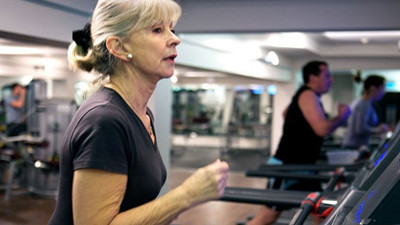Science and technology
科學技術
Exercise and longevity
鍛煉與長壽
Worth all the sweat
出點汗,值了!
Just why exercise is so good for people is, at last, being understood
為什么鍛煉有利于身體健康呢,人們終于知道答案了
ONE sure giveaway of quack medicine is the claim that a product can treat any ailment.
有一種絕對能推銷出去狗皮膏藥的方法就是說它包治百病。
There are, sadly, no panaceas.
遺憾的是靈丹妙藥并不存在。

But some things come close, and exercise is one of them.
但有些方法卻起到類似的作用,鍛煉就是其中之一。
As doctors never tire of reminding people, exercise protects against a host of illnesses,
醫生們一直不厭其煩地提醒人們鍛煉身體有助于防范一系列疾病,
from heart attacks and dementia to diabetes and infection.
包括心臟病、癡呆癥、糖尿病以及感染。
How it does so, however, remains surprisingly mysterious.
但是人們一直不知道為什么。
But a paper just published in Nature by Beth Levine of the University of Texas Southwestern Medical Centre and her colleagues sheds some light on the matter.
德克薩斯大學西南醫學中心貝絲萊文及其同事最近在《自然》雜志發表的論文給出了一些解釋。
Dr Levine and her team were testing a theory that exercise works its magic, at least in part, by promoting autophagy.
萊文博士及其小組證明一個理論的正確性,即鍛煉之所以有神奇的作用,
This process, whose name is derived from the Greek for self-eating,
部分原因是它能促進自體吞噬。
is a mechanism by which surplus, worn-out or malformed proteins and other cellular components are broken up for scrap and recycled.
這個名稱來自希臘詞語自食其肉,指的是多余的、不能再用的、畸形的蛋白質和其他細胞成分被分解成碎片并再循環。
To carry out the test, Dr Levine turned to those stalwarts of medical research, genetically modified mice.
萊文博士在這個實驗中使用轉基因老鼠作為實驗對象,醫學研究中經常使用轉基因老鼠。
Her first batch of rodents were tweaked so that their autophagosomes,
第一組老鼠被調整使得其細胞中的自噬體發出綠光,
structures that form around components which have been marked for recycling—glowed green.
這種結構形成的部分被用于再循環。
After these mice had spent half an hour on a treadmill,
這些老師被放在跑步機上半個小時后,
she found that the number of autophagosomes in their muscles had increased,
萊文博士發現它們肌肉中的自噬體增加了,
and it went on increasing until they had been running for 80 minutes.
直到跑了80分鐘才停止增加。
To find out what, if anything, this exercise-boosted autophagy was doing for mice,
為了找出這種由鍛煉刺激的自噬作用對老鼠有什么作用,
the team engineered a second strain that was unable to respond this way.
研究小組設計了另一組不能如此反應的老鼠。
Exercise, in other words, failed to stimulate their recycling mechanism.
換句話說,鍛煉并沒刺激再循環機制。
When this second group of modified mice were tested alongside ordinary ones,
當第二組的轉基因老鼠和普通老鼠一起接受實驗時,
they showed less endurance and had less ability to take up sugar from their bloodstreams.
它們的耐力遜于后者,也不能很好地從血液中吸收糖分。
There were longer-term effects, too.
還有長期影響。
In mice, as in people, regular exercise helps prevent diabetes.
老鼠和人一樣,定期鍛煉有助于預防糖尿病。
But when the team fed their second group of modified mice a diet designed to induce diabetes,
但是在研究小組給第二組轉基因老鼠喂了一種專門用來誘發糖尿病的食物后,
they found that exercise gave no protection at all.
他們發現鍛煉并沒有任何預防效果。
Dr Levine and her team reckon their results suggest that manipulating autophagy may offer a new approach to treating diabetes.
萊文博士及其小組認為實驗結果表明受到操縱的自噬作用有可能提供一種新的治療糖尿病的方法。
And their research is also suggestive in other ways.
他們的研究在其他方面也有啟示。
Autophagy is a hot topic in medicine,
自噬作用在醫學界是個熱門話題,
as biologists have come to realise that it helps protect the body from all kinds of ailments.
因為生物學家逐漸意識到它能抵御各種小病。
The virtues of recycling
再循環的功效
Autophagy is an ancient mechanism, shared by all eukaryotic organisms.
自體吞噬機制很古老,所有真核生物都有。
It probably arose as an adaptation to scarcity of nutrients.
它的產生可能是為了適應營養物質的缺乏的環境。
Critters that can recycle parts of themselves for fuel are better able to cope with lean times than those that cannot.
有些家畜能循環利用它們身體的一部分作為養料,這樣的動物比其他的動物在食物匱乏期更容易生存。
But over the past couple of decades,
但是在過去幾十年里,
autophagy has also been shown to be involved in things as diverse,
自體吞噬在其他很多地方也有所體現,
as fighting bacterial infections and slowing the onset of neurological conditions like Alzheimer's and Huntington's diseases.
比如對抗細菌感染、放緩老年癡呆癥和亨丁頓舞蹈癥等神經癥狀的發病。
Most intriguingly of all, it seems that it can slow the process of ageing.
最有趣的是,看起來它還延緩了老化過程。
Biologists have known for decades that feeding animals near-starvation diets can boost their lifespans dramatically.
生物學家幾十年來都知道在動物保持接近饑餓的狀態下喂食能大幅度提高它們的壽命。
Dr Levine was a member of the team which showed that an increased level of autophagy, brought on by the stress of living in a constant state of near-starvation,
萊文博士曾經工作的一個小組證明在長期接近饑餓的狀態下生存的壓力引起了自體吞噬水平的提高,
was the mechanism responsible for this life extension.
這種原理使得壽命延長。
The theory is that what are being disposed of in particular are worn-out mitochondria.
被處理掉的其實是衰弱的線粒體。
These structures are a cell's power-packs.
這種結構給細胞提供能量。
They are where glucose and oxygen react together to release energy.
在線粒體里,葡萄糖和氧氣共同作用釋放能量。
Such reactions, though, often create damaging oxygen-rich molecules called free radicals,
不過這種反應卻常常制造出有害的富氧分子,即自由基,
which are thought to be one of the driving forces of ageing.
它是促成老化的原因之一。
Getting rid of wonky mitochondria would reduce free-radical production and might thus slow down ageing.
除掉沒用的線粒體可以減少自由基的生成,這樣就可能減緩老化過程。
A few anti-ageing zealots already subsist on near-starvation diets,
一些反老化的狂熱分子已經開始靠保持饑餓狀態的飲食為生了,
but Dr Levine's results suggest a similar effect might be gained in a much more agreeable way, via vigorous exercise.
但是萊文博士的實驗結果表示通過積極鍛煉身體這樣一種更隨和的方式也能得到類似的效果。
The team's next step is to test whether boosted autophagy can indeed explain the life-extending effects of exercise.
該小組下一步將測試被激發的自體吞噬是否真的能解釋鍛煉有助于長壽。
That will take a while.
這尚需時間方能出結果。
Even in animals as short-lived as mice, she points out, studying ageing is a long-winded process.
她指出即使研究像老鼠這樣壽命很短的動物也是長期曲折的過程。
But she is sufficiently confident about the outcome that she has, in the meantime, bought herself a treadmill.
但是她對結果非常自信,于此同時還給自己也買了一個跑步機。











